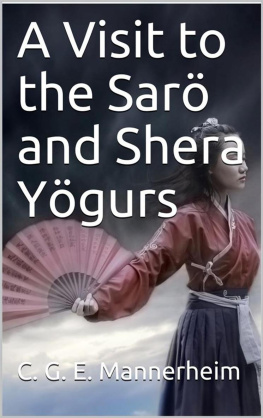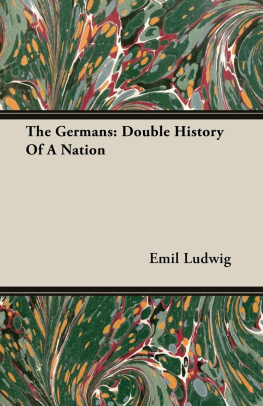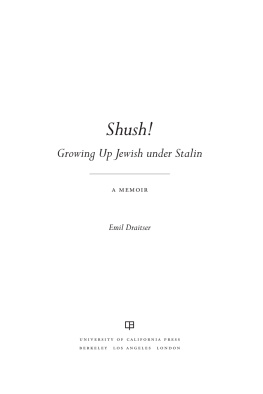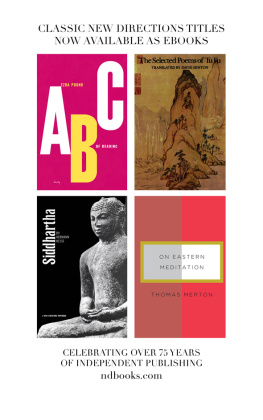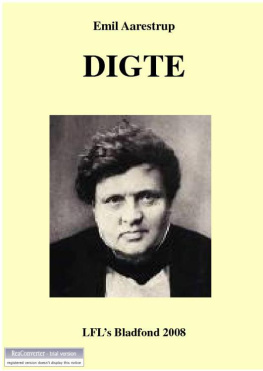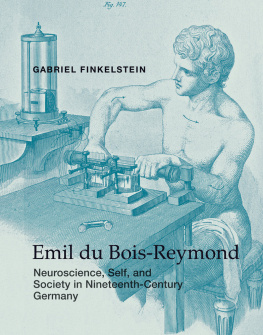A VISIT TO THE SAR AND SHERA YGURS
by
C. G. E. MANNERHEIM
Helsingfors,The Finnish Literary Society,1911.
Introductory note.
During an expedition made in Central Asia and Northern China in theyears 1906-1908 I had the opportunity of spending some days among theSar and Shera Ygurs, two small tribes which under the common nameof "Huang-fan" (the yellow barbarians) inhabit the northern reachesof the Nanshan mountains in the district of Kanchow-Hsuchow, andpart of the plain at its foot. In the hope of assisting in spreadingsome light upon these imperfectly known races, I offer some extractsfrom my journal, a vocabulary of words noted down parallely, as usedby both tribes, some anthropological measurements and a number ofphotographs, some of which were taken during my expedition, othersrepresenting an ethnographical collection which I made.
In making the vocabulary, the words have been taken down phonetically.Dr Ramstedt of the Alexander University at Helsingfors, has kindlysupplied the Mongolian equivalent. In my anthropological andethnographical observations I have followed the directions I found in"Notes and Queries" on Anthropology given by John George Garson, M.D.and Charles Hercules Read, F.S.A., and in "Ethnography", by the latterauthor.
Unfortunately some of the photographs have been less successful thanothers owing to the fact that a stress of work obliged me to postponefor some months the developing of some dozen films.
As the principal aim of my expedition lay altogether outside thespheres of anthropology and ethnography, and as I have had noopportunity to revise my more or less casually made observations,it is without the least claim to authority that I present this veryunpretentious material to the kind consideration of the reader.
Helsingfors, August 10th 1909.
C.G.E. Mannerheim.
I
Among the Sar Ygurs.
At dawn on December 13th 1907, we started upon our expedition, and wesoon left behind us the pleasant little Chinese town Chin-t'a, with itshalfrounded, irregular clay walls, so unlike the strictly symmetricalChinese type, its narrow, winding alleys, its temple courts shaded byancient gnarled trees, and its towers with their innumerable bellsall tinkling in the wind. Our road led in a SE direction, past atemple with a high conical tower which except for the missing gildingstill gave reason for the town's name, (chin 'gold', t'a 'tower';Chint'a 'the golden tower') and we over the ruins of a wall, whichformerly enclosed this oasis one of the most northerly outposts ofChinese civilisation, in the sand and gravel ocean of the Gobi Desert.
Beyond the wall extended a sandy, sterile stretch of ground, which, atfirst thickly bestrewn with Chinese tombstones, rose gradually towardsa low chain of hills lying in a ESE-WNW direction. In character, theseresembled a number of narrow gravel ridges, some of which formed acrest, others rising in terraces. A slight pass which we rode throughat about twelve kilometres from the town was the highest point reachedthat day, and the descent southwards was even less perceptible than ourascent. The only vegetation to be seen was some insignificant creepingbrush, growing in tufts at lengthy intervals. About nine kilometresfrom the pass the belt of gravel merged into a sandy formation, dottedthickly with knolls on which grew more of the same creeping brush,though of somewhat larger growth. Some few kilometres further, reedsappeared, and these soon gave place to a typical porous soil witha strong salty deposit. As far as the eye could see, the sameinhospitable kind of country extended, sparsely covered by grasstowards the south, where it merged into the Nan-shan mountains,the outlines ol which could be discerned in the misty distance.
The great high road joining K'ou-li (the territory inside theGreat Wall) and K'ou-wai (the territory outside) has in North Kansuan E-W direction and at Shuang-t'ingtzu, twenty-seven kilometresfrom Chint'a, we crossed one of the innumerable etape stations whichfaithfully follow its course all the way from the Pacific Ocean to thedistant plains of Russia and India. Some seven or eight kilometressouth of the road, we rode past the first of the scattered dwellingsof the Ygur village of Ma-chuang-tzu. I dismounted to get a nearerview of three women who were busy in the yard of the house. They worea strange costume such as I had never seen before. The eldest, a womanof fifty, with a Roman nose and a generally dignified appearance, wasvery talkative. She offered us tea, and told us they were Sar Ygurs a name which she repeated proudly several times. The other two womenhad prominent cheek bones, small eyes, thick ugly noses, and were of acommon appearance. My camera, which I brought out carelessly, changedhowever the mental atmosphere at a stroke. There was a sudden end toconfidences and there remained nothing for us but to continue our wayto the village temple, distant 12-13 km to the south.
Built near the remains of a small ruin, the plain temple buildings soonrose before us, surrounded by a small group of wooden huts occupiedby the lamas. None of the lamas were at home but the Chinese officerin command of the Shuangt'ingtzu mounted guard gave unhesitatinglyorders that my things should be carried into the cleanest of thehouses. All was arranged in a moment and the house looked as if wehad always lived there. Hashim was busily washing rice, cleaningcarrots and preparing the mutton for the ever-appetising palao,with which he had delighted us for the last seventeen months, Chou,my seventeen-year-old interpreter arranging the meteorologicalinstruments, Lukanin, the Cossack of the expedition, and Hsu, a retiredChinese Colonel, now in my service, saw to the horses and equipments,while at the scanty kitchen fire, I tried to thaw my fingers, stifffrom the cold December breeze, to start work on notebooks and maps.
The lamas, on their arrival, appeared somewhat surprised at ourintrusion but though the first meeting was rather cool, the ice soonwas broken, and my host, in particular, grew both hospitable andtalkative.
Machuangtzu is a village of about forty houses spread over a widearea, occupied by people who call themselves Sar Ygur ('yellowYgurs') and called by the Chinese Huang Fantzu (huang 'yellow',fan 'barbarian'; 'the yellow barbarians') to distinguish them fromthe Tangutans, who are called Hei Fantzu (hei 'black'). A legend,imparted from father to son, says that more than a thousand years ago,their forefathers came from the west, where they had inhabited a city,bearing the name Shiche-Hache, called by the Chinese Chenfu tun.It lay, they said, a forty-five days' march to the west or southwest,on the shores of a river and was surrounded by high mountains. InShiche-Hache, a temple had been built with many excavated caves inthe mountain. According to another Ygur version, they had movedto their present dwelling places during the reign of the EmperorK'ang-hsi, to escape a contagious disease, the name of which myinterpreter gave as cholera. Some of the tribe had settled in themountains S and SE of Hsuchow, the remainder on the plain. Those whohad settled nearest Hsuchow had become amalgamated with the Chinese,the others still retained their language. The ruin near the presenttemple had belonged to a race of people, having tails, whom the Chinesecall Kuzurkei.
About forty kilometres eastward from Machuangtzu lies a village, calledTung-heitzu, also consisting of forty or fifty homesteads, with atemple, and about thirty kilometres south of the town Kaot'ajthere is still another called Yumashan Huang Fantzu, where the samelanguage is spoken. Further south, at

